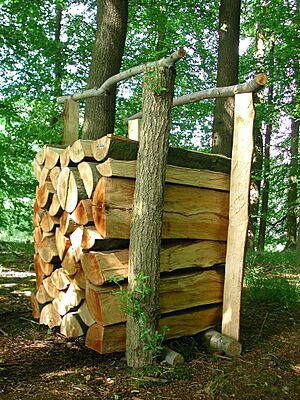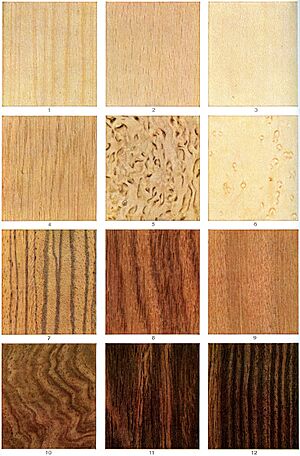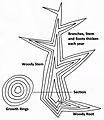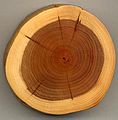Wood facts for kids
Wood is the main material that makes up trees. It is mostly formed by special tubes called xylem vessels. These tubes carry water from the roots up to the rest of the plant. The two main things that make up wood are cellulose and lignin.
Wood is a very useful material. People use it to build buildings and furniture. It is also used to create art. Firewood is a type of wood used as fuel to make fires. Even paper is made from tiny wood fibres. Wood is a renewable resource, meaning it can grow back. However, it has become harder to find in some places over the last few centuries.
Wood is strong and tough. It can be hard to cut. A lumberjack is a person whose job is to cut down trees. After a tree is cut, its wood can be cut into long, straight pieces called lumber. Lumber can then be used to make posts. It can also be joined together with nails, screws, or glue to create wooden frames for many different shapes.
There are many different kinds of wood. Some common types are Oak, maple, pine, and redwood. Woods are usually put into two main groups: softwood and hardwood. Softwood comes from conifer trees, which often have needles and cones. Hardwood comes from flowering plants, which usually have broad leaves.
Contents
Wood for Homes
For a very long time, and even today, many buildings, especially houses, are made of wood. To build a house with wood, lumber is put together to form frames. These frames create the shape of each wall, floor, and the roof of the house. Once the frames are in place, they can be covered to make solid walls. Sometimes, the outside walls are also made of wood.
When the outside of a house is covered in wood, the wooden pieces are usually flat and stacked. These pieces are called shingles. Wood is also used for other parts inside a house. This includes doors and staircases. You can also see wood used to make fences around yards.
Working with Wood
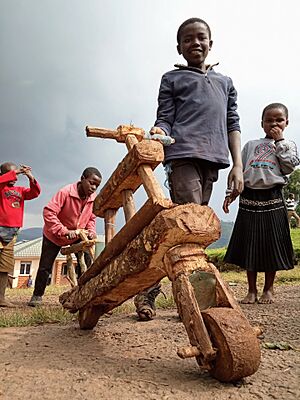
Carpenters are people who build things with wood. They often use soft wood like pine to build houses. For many types of furniture, they use harder wood such as maple or oak. When someone builds something with wood, they often paint it. Paint helps to protect the wood and makes it look nice.
Some people like the natural look of wood. They might put a clear paint called varnish on it. Varnish helps protect the wood and gives it a shiny finish.
Some artists create sculptures and other art using wood. A famous wood sculptor was Grinling Gibbons.
Even regular pencils are made of wood. Inside the pencil is the "lead". This "lead" is not actually the metal lead. It is made from clay or wax mixed with graphite.
How Wood Becomes Paper
Wood is turned into paper in huge factories called paper mills. In these factories, heat, chemicals, and machines are used. They separate the tiny cellulose fibers from other parts of the wood. Then, these fibers are pressed together to make paper.
Related pages
Images for kids
-
Diagram of how a tree grows wider each year. A new layer of wood is added, forming a growth ring.
-
A cut piece of Yew wood showing 27 growth rings, light sapwood, dark heartwood, and the center pith.
-
The wood of a coast redwood tree is a distinctive red color.
-
A magnified view of black walnut wood, showing its vessels and annual rings.
-
Earlywood and latewood in a softwood, from a Rocky Mountain Douglas-fir.
-
Earlywood and latewood in a ring-porous wood like European ash.
-
Trunks of the Coconut palm in Java.
-
The chemical structure of lignin, which gives wood many of its strong properties.
-
A refinery in Rauma, Finland, where chemicals from wood are processed.
-
The Saitta House in Dyker Heights, Brooklyn, built in 1899, is made and decorated with wood.
See also
 In Spanish: Madera para niños
In Spanish: Madera para niños


